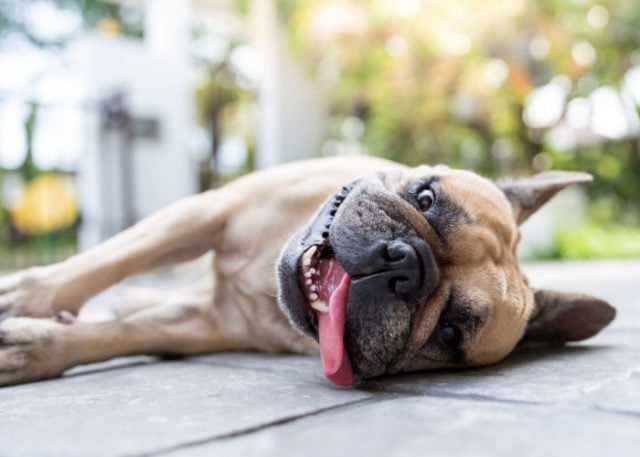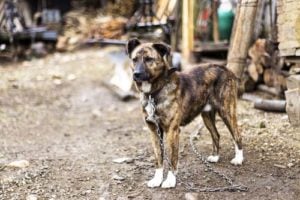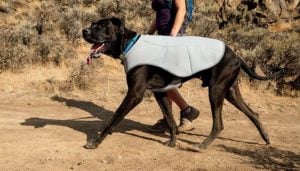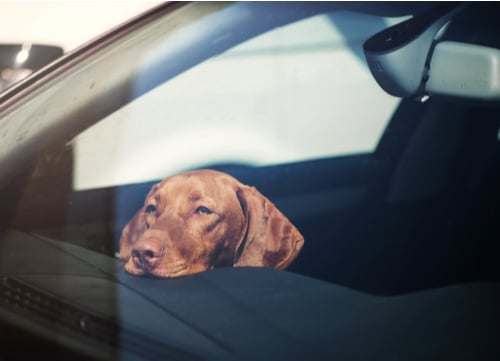
Table of Contents
- 20 Ways to Prevent Heatstroke in Dogs
- 1. Pay Attention to Your Dog’s Condition
- 2. Know the Signs of Heatstroke in Dogs
- 3. Don’t Leave Your Dog Outside
- 4. Restrict Your Dog’s Exercise Outdoors
- 5. Time Walking with Sunrise and Sundown
- 6. Protect Your Dog's Paws
- 7. Choose Cooler Areas for Walking
- 8. Use Cooling Vests and Bandanas for Dogs
- 9. Never Leave Your Dog in the Car
- 10. Use Window Shades in Your Car
- 11. Do NOT Shave Your Dog
- 12. Do NOT Muzzle Your Dog
- 13. Constant Access to Clean Water
- 14. Get a Dog Pool
- 15. Always Be Aware of the Heat
- 16. Temperature-Controlled Accommodations
- 17. Have a Backup Plan for Power Outages
- 18. Buy a Cooling Mat for Dogs
- 19. Keep Sick Dogs Indoors
- 20. Offer Your Dog Icy Treats
- FAQs
- Before You Go…
When the summer heat is in full swing, so are the summer dangers for dogs, including heatstroke.
Canine heatstroke occurs when the heat exceeds the dog's ability to dissipate it. This is a serious condition that may result in:
- vascular damage
- kidney damage
- liver damage
- gastrointestinal damage
- dysfunction in the central nervous system
- death (when not treated immediately)

Multiple studies show that the treatment for dogs that suffer from heatstroke is complex, expensive, and not always successful.
Other studies show that heatstroke in dogs results in serious complications and a near 50% fatality rate despite appropriate treatment.
A moderate level heat stroke (temperature over 104°F) can usually be treated within an hour, but a severe one (temperature over 106°F) could quickly become fatal.
The higher the dog's temperature and the longer it takes for them to get treatment, the worse the outcome will be.
True to the words we always hear: prevention is better than a cure.
So when the sun is out, the weather is hot, and the temperature is high, follow these tips to prevent heatstroke in dogs.
RELATED: How to Prepare Your Dog for Summer
20 Ways to Prevent Heatstroke in Dogs
1. Pay Attention to Your Dog’s Condition
Some breeds are more susceptible to overheating and heatstroke.
These dogs are:
- active breeds, like Labrador Retrievers
- brachycephalic (flat nose and short muzzle), like Shih Tzus and Pugs
- double-coated dogs, like Siberian Huskies
- with existing health conditions like heart disease, old age, obesity, and respiratory conditions
If your dog falls into any of these categories, it is essential to keep your pet as cool as possible in the heat.
2. Know the Signs of Heatstroke in Dogs
Heatstroke in dogs can progress rapidly, and the sooner it is detected, the more likely your dog will be to survive.
The common signs of canine heatstroke include:
- Body temperature of 104°F or higher
- Rapid heartbeat
- Excessive thirst
- Lethargic behaviors
- Glazed eyes
- Vomiting
- Heavy panting
- Bright red gums and tongue
- Excessive drooling
- Lack of coordination
- Seizures
- Bloody diarrhea
- Unconsciousness
Once you notice these signs in your dog, begin treatment immediately, even if you aren’t one hundred percent positive that it's heatstroke. Better to be safe than sorry!
Do these:
- Bring your dog into a cool area and, if possible, run cool (not cold) water over their coat.
- If you cannot get your dog into the bathtub, use cool, wet towels on your dog’s underside to help them cool down.
- Encourage your dog to drink.
- Use fans to help circulate air and cool your dog, but do not point fans directly at a panting dog, as it can cause bloating.
RELATED: 10 Tips on How to Keep Dogs Cool Outside In Summer
3. Don’t Leave Your Dog Outside
 Never leave your dog outside in the heat for any period. This is a common cause of heatstroke in dogs; many dogs die from this.
Never leave your dog outside in the heat for any period. This is a common cause of heatstroke in dogs; many dogs die from this.
This means that “outside dogs” should be brought inside or given temperature-controlled accommodations.
This also means that potty visits should be kept short, and dogs should not be left outdoors to play.
Even in the shade, a dog in your backyard can quickly overheat.
If outdoor activities are necessary, plan and keep in mind that shade will move throughout the day, so make sure there will be adequate shade the entire time Fido is outside.
4. Restrict Your Dog’s Exercise Outdoors
Speaking of outdoor activities, when it’s hot or humid, avoid pushing your dog’s exercise limits.
Strenuous activities, such as running, playing fetch, or playing frisbee, cause your dog’s body temperature to rise quickly.
It’s harder for dogs to cool down in hot and humid temperatures, so they’re much more likely to overheat.
Dogs use evaporation to cool their bodies when they pant. When the humidity in the air is higher, evaporation is slower, meaning it takes longer for your dog to cool down.
Too much exercise or playtime in hot weather can result in heatstroke in dogs much more quickly than you might suspect.
RELATED: Can You Overexercise Your Dog? 12 Signs to Watch Out For!
5. Time Walking with Sunrise and Sundown
 Walking and light physical activity is still important in the summer, but it's best to time them when the sun is not at its hottest.
Walking and light physical activity is still important in the summer, but it's best to time them when the sun is not at its hottest.
Your best bet? Walk them before sunrise or after sunset. This allows walking surfaces and the air to cool down sufficiently.
Walking surfaces absorb the sun's heat and can almost double in temperature, which can be particularly hazardous for dogs.
If the temperature outside is 86°F, it can reach about 135°F on asphalt, which is definitely not safe for your dog's paws.
6. Protect Your Dog's Paws
“But even in relatively mild temperatures, burns to a pet’s pads can result if forced to walk on the hot surface.” – Dr. Raelynn Farnsworth, DVM (source)
Protecting your dog's paws from hot surfaces will not only help prevent heatstroke in dogs but also keep your dog's feet healthy and in good condition.
To protect the dog's paws from the asphalt heat, consider choosing alternative paths to walk on or using dog shoes, socks, or paw protection waxes.
If, however, it's too late and your dog has already burned his paws on hot asphalt, you can use paw balms to relieve the pain and speed up the healing process.
RELATED: 7 Most Common Dog Paw Problems and What to Do About Them
7. Choose Cooler Areas for Walking
Even if you protect your dog's paws with dog booties or paw waxes, it's best to avoid hot areas and choose shade over burning sun every time.
When the temperature has cooled enough to walk your dog, try to stick to cooler areas to further reduce the temperature.
Walk your dogs on a wooded path rather than on a sidewalk around your development.
8. Use Cooling Vests and Bandanas for Dogs
 Cooling vests and bandanas will allow you and your pet to spend more time outside without the risk of heat exhaustion and heat stroke.
Cooling vests and bandanas will allow you and your pet to spend more time outside without the risk of heat exhaustion and heat stroke.
Dog cooling vests are harnesses specifically designed for dogs that provide external cooling, while bandanas provide skin contact with a cool pad by freezing them before use.
Most often, these are used on working dogs that must be outdoors in heat, but they can also be pretty useful for senior dogs and overweight dogs to cool off on summer days.
Feverish dogs will also benefit from them as they provide an instant cooling effect.
RELATED: 20 Cool Dog Summer Accessories
9. Never Leave Your Dog in the Car
This warning has become a cliché by now, but many pet owners still ignore it.
Leaving your dog in the car poses multiple dangers, whether in summer or winter, but it's especially dangerous when it's hot outside.
A Stanford University study found that when the outside temperature is 72°F, a car’s internal temperature can reach 116°F within an hour. When the temperature is 85°F, a vehicle can reach 102°F in 10 minutes and 120°F in 20 minutes. Dogs are never safe in these conditions.
Note that there are now laws making it illegal to leave dogs in cars, so not only will you put your dog's life in danger, but you could also be facing legal repercussions.
RELATED: Leaving A Dog Inside A Hot Car? Don't Do It!
10. Use Window Shades in Your Car
If you do have to travel with your dog during the summer months, put up sunshades on the windows of your car.
Most often used for babies, these shades keep direct sunlight off your dog and can easily be taken down when not in use.
You can also get a dog-friendly fan for cars that will keep your dog cool in case the regular car setup doesn't work or doesn't provide enough cold for the dog.
11. Do NOT Shave Your Dog
Some dogs can benefit from a trim of their coat during the summer months, but you should NEVER shave your dog’s coat completely, and we've already discussed all the reasons why shaving your dog for summer is bad.
Your dog’s coat not only keeps them warm in winter, but it also helps to regulate their temperature in summer.
Their coats protect them from sunburn, with their undercoats helping to insulate their bodies against excessive heat.
RELATED: Shaving Your Dog For Summer: Should You Do It?
12. Do NOT Muzzle Your Dog
Muzzles can increase the chances of heatstroke in dogs. It restricts your dog’s ability to pant and cool down, which could cause your dog to overheat very quickly.
If your dog exhibits any fear or aggression and requires a muzzle, consider engaging in indoor activities during the summer months instead.
Activities like hide-and-seek or fetch can help burn off excess energy and stimulate your dog safely.
13. Constant Access to Clean Water
Clean, cool water keeps your dog hydrated and helps regulate their body temperature. Ensure it's always accessible wherever your dog may be.
A great way to do this is to wash and refill your dog’s water bowl at least three times a day. If you tend to forget, get one of the automatic water bowls instead.
You can also put ice in your dog’s water to keep it cooler for longer.
14. Get a Dog Pool
If you don't have a pool in your backyard, you can get a dog swimming pool to help cool off your dog!
There are numerous swimming pools designed specifically to help cool off dogs and prevent damage and scratches.
If a full-on swimming pool isn't an option, a paddling pool for dogs (similar to those used by kids for play) is another good way to cool off your dog in the summer.
15. Always Be Aware of the Heat
Not because your pet is swimming does it mean they will not suffer from heatstroke.
Yes, the water can bring down your dog’s body temperature, but the atmospheric temperature can still cause your dog to overheat.
If your dog is in the pool during the summer, limit their swimming times to short 15-minute to 30-minute intervals and watch for signs of overheating.
RELATED: How Hot Is Too Hot for A Dog?
16. Temperature-Controlled Accommodations
If you keep your dog in an area that is not temperature-controlled, you may want to consider changing that.
 If there's no access to air conditioning, consider an in-window AC unit or at least a portable fan. There are plenty of cheap dog-friendly fans that will give your dog some relief from summer's heat.
If there's no access to air conditioning, consider an in-window AC unit or at least a portable fan. There are plenty of cheap dog-friendly fans that will give your dog some relief from summer's heat.
If your dog usually sleeps in the garage, consider installing an air conditioning unit for them or bringing them inside the main part of your home, which is air-conditioned.
For dogs that sleep in their dog crates, you can get a crate cooling fan to provide some relief.
17. Have a Backup Plan for Power Outages
If your area is prone to power outages that may cause your home to become unbearably hot for your family and dog, have a backup plan!
Consider installing a generator to keep a window air conditioning unit running, or stay with friends until your power returns.
18. Buy a Cooling Mat for Dogs
 For dogs that struggle to maintain their body temperature in the summer, consider buying a cooling mat.
For dogs that struggle to maintain their body temperature in the summer, consider buying a cooling mat.
These dog cooling mats are pressure-activated and provide a cool, padded surface where your dog can lie, making them one of the most popular ways to provide cool relief for dogs today.
Once your dog lies down, the mat begins to cool against their exposed underbelly, helping to bring down their body temperature more rapidly.
Cooling mats vary in size and price and can be highly beneficial for dogs with thick coats, elderly dogs, or those with certain health conditions.
They are a simple and cheap way to prevent heatstroke in dogs.
RELATED: Different Types of Dog Cooling Products: Mats, Beds, Vests, Bandanas, Collars
19. Keep Sick Dogs Indoors
If your dog is experiencing a brief illness, such as a stomach upset or canine flu, keep them indoors. Sick dogs dehydrate very quickly, and the added weakness from illness can exacerbate heatstroke.
20. Offer Your Dog Icy Treats
During particularly hot summer days, offer your dog icy treats or make dog ice cream to help them cool down.
Some dogs enjoy ice cubes, but if your dog doesn’t, I find that freezing pieces of dog-safe fruit into the water in ice cube trays works just as well, like this DIY Ice Lick.
RELATED: Recipe: Easy Frozen Dog Treat
FAQs
How to cool down a panting dog?
Move your dog to a shaded or air-conditioned area, offer cool (not ice-cold) water, and use a damp towel or cooling mat to help lower their body temperature.
You can also place a fan nearby to promote airflow. Avoid strenuous activity until your dog is fully cooled down.
RELATED: Excessive Panting in Dogs and What You Should Do
Do dogs sleep more when it's hot?
Yes, some dogs tend to sleep more in hot weather to conserve energy and avoid overheating.
Just like humans, they may become lethargic due to the heat. What's important is they always have a cool, comfortable space to rest.
Before You Go…
If you suspect heatstroke in dogs, take action immediately.
Begin cooling your dog down, especially when the temperature reaches 104°F or higher.
Once your dog’s temperature drops to 103°F or lower, take them to a veterinarian. This ensures that the heatstroke is gone, that your dog has the fluids he needs, and that he won't suffer any long-term effects.
Learn more about caring for dogs in hot weather in our recommended articles linked below!
Related Articles
- 20 Worst Dog Breeds for Hot Weather
- How To Cure Fever in Dogs?
- Huskies in Summer: Can They Keep Up with the Heat?
Want to share this?


















